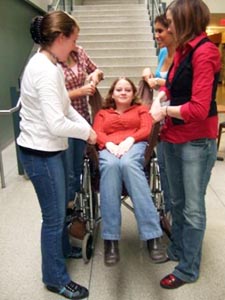Patient Lifting

Patient lifting is a daily routine for most health care providers and family members assisting disabled loved ones. If done improperly you can strain your back and knees, and it can be dangerous to a disabled person.
Here are a few safety hints.
- If possible, never lift alone – lifting a patient is not like lifting a box. Boxes are stationary. People move, especially if they feel pain. If they are too heavy for you, it can be easy to lose your grip or your balance. Safe lifting is always done with at least one other person.
- Use a lifting aid –Using a lifting aid such as the Tuk-‘N-Kari™ or a gait belt helps you and your partner to center the weight of the patient. Such devices also keep the patient as stationary as possible while they are being moved.
- Lift with your arms and legs, not your back – Back injuries from incorrectly moving patients are common in healthcare settings. When you grab the device, be sure you have a good grip on it. Bending your legs gives you a stable base from which to move. Tightening your midsection protects your back from injury. Maintain your equal distribution of weight until the patient is safely moved.
- Stand as close to the patient as possible – Patient lifting is not only used for transferring but also patient positioning. Changing the bed linens or putting the patient on a bedpan requires a change in position that can’t always be accomplished independently. Standing right next to the patient’s bed provides the greatest amount of balance and leverage when lifting.
These safety hints are also important to know in emergency
situations. In the event you have to move someone quickly from a
building fire, accident scene or other area, keep these tips in mind to
get the job done safely for both the rescuer and person being rescued.
Never lift alone and be prepared with a device like the
Tuk-‘N-Kari™.
Back to Wheelchair Safety
Back to Home Page from Patient Lifting